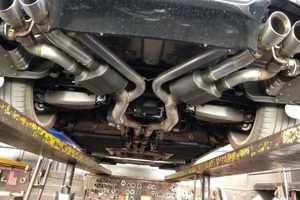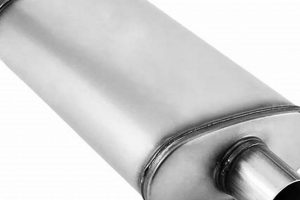The process of removing accumulated carbon deposits and other contaminants from a motorcycle exhaust silencing component is a maintenance procedure that aims to restore optimal engine performance and reduce unwanted noise emissions. This activity typically involves disassembly, application of cleaning agents, and reassembly of the exhaust system’s terminal component.
Maintaining the cleanliness of this component offers several advantages. It can improve fuel efficiency by reducing back pressure within the exhaust system. A cleaner system also contributes to a more environmentally sound operation by ensuring efficient combustion. Historically, the removal of carbon buildup has been a standard practice in motorcycle maintenance, ensuring longevity and consistent performance.
The subsequent sections will detail specific methods and precautions involved in achieving a thorough and safe cleaning of the aforementioned component. Information on identifying different types of build-up, selecting appropriate cleaning solutions, and performing the cleaning procedure are provided.
Tips for Exhaust Silencer Maintenance
The following guidelines provide instruction on the proper maintenance and cleaning to extend the life and improve the function of a motorcycle exhaust silencing component. Adherence to these recommendations will contribute to optimal engine operation and reduce the risk of damage.
Tip 1: Identify Material Composition. Determine the material from which the exhaust component is constructed. Different materials, such as chrome, stainless steel, or aluminum, require specific cleaning agents and techniques to prevent corrosion or discoloration.
Tip 2: Disassemble with Caution. When disassembling the exhaust system, ensure all fasteners are loosened carefully to avoid stripping threads or damaging components. Applying penetrating oil may be necessary for heavily corroded fasteners.
Tip 3: Select Appropriate Cleaning Agents. Utilize cleaning solutions specifically formulated for exhaust system components. Avoid abrasive cleaners that can scratch or damage the finish. Consult the motorcycle manufacturer’s recommendations for approved cleaning products.
Tip 4: Implement a Soaking Period. For heavily carbonized components, consider soaking in a cleaning solution for an extended period. This softens the deposits, making removal easier and reducing the need for aggressive scrubbing.
Tip 5: Use Appropriate Tools. Employ tools such as soft brushes, pipe cleaners, and specialized exhaust cleaning tools to remove carbon deposits without damaging the interior surfaces.
Tip 6: Ensure Thorough Rinsing. After cleaning, thoroughly rinse all components with clean water to remove any residual cleaning agents. This prevents potential corrosion or chemical reactions during operation.
Tip 7: Apply Protective Coating. Consider applying a heat-resistant protective coating to the cleaned exhaust component. This helps prevent future carbon buildup and protects the finish from environmental elements.
Tip 8: Reassemble with Precision. During reassembly, ensure all gaskets and seals are in good condition and properly seated. Tighten fasteners to the manufacturer’s specified torque values to prevent leaks or damage.
Following these tips will promote longevity, performance, and appearance of the exhaust system component. Consistent and proper maintenance reduces the likelihood of costly repairs and ensures continued enjoyment of motorcycle operation.
The information presented serves as a preliminary guide for proper cleaning and maintenance. Consult a qualified motorcycle mechanic for specific recommendations and guidance on maintaining the exhaust system.
1. Disassembly Precautions
The successful execution of exhaust silencing component cleaning hinges significantly on the disassembly process. Damage to fasteners, seals, or exhaust components during disassembly directly impacts the effectiveness of subsequent cleaning stages and reassembly. Corrosion, often present within exhaust systems, can seize fasteners, necessitating cautious removal techniques. Failure to employ such techniques frequently results in damaged threads, rounded bolt heads, or broken components, hindering proper reassembly and compromising the exhaust system’s seal. A real-world example involves attempting to remove a rusted bolt using excessive force, leading to breakage within the exhaust manifold, thereby necessitating costly repairs.
Prior to initiating disassembly, penetrating oil application on all fasteners allows for lubricant to seep into corroded areas, reducing friction and minimizing the risk of breakage. The identification of fastener types and their corresponding removal tools is paramount. Using the incorrect tool can damage the fastener head, complicating removal. Careful observation of component orientation during disassembly is crucial, ensuring proper reassembly and maintaining original exhaust flow characteristics. Furthermore, the proper handling of gaskets and seals prevents damage or tearing, ensuring a tight seal upon reassembly. If gaskets are damaged, replacement with new components is required.
Effective disassembly, therefore, is not merely a preliminary step but an integral component of exhaust system cleaning. Prioritizing careful, methodical disassembly minimizes the risk of component damage, facilitating a more effective cleaning process and ensuring the exhaust system functions optimally upon reassembly. Neglecting these precautions can negate the benefits of the cleaning process, leading to operational inefficiencies and potentially more extensive repairs.
2. Material Compatibility
The interaction between cleaning agents and the metallic composition of an exhaust silencing component is a critical factor determining the success and longevity of any cleaning procedure. Varying alloy formulations, such as stainless steel, chrome, titanium, and aluminum, exhibit distinct chemical reactivities. The application of an incompatible cleaning solution can initiate corrosive processes, leading to aesthetic degradation, structural weakening, and premature component failure. For instance, using acidic cleaners on chrome-plated surfaces can result in pitting and loss of luster, while alkaline solutions may etch aluminum, altering its surface finish and potentially affecting its integrity. The selection of cleaning products must, therefore, align with the specific metal or alloy present in the exhaust component to preclude adverse reactions.
Manufacturers typically specify the material composition of exhaust components, providing a basis for informed cleaning agent selection. When material identification is uncertain, a cautious approach is warranted. The initial application of a cleaning solution on a small, inconspicuous area allows for observation of any immediate reactions, such as discoloration, bubbling, or surface erosion. Neutral pH cleaners are generally considered safer options, minimizing the risk of corrosion across a range of metals. The presence of heat-shielding coatings or applied finishes further complicates cleaning agent selection, as certain solvents may dissolve or damage these protective layers, compromising the component’s ability to withstand high operating temperatures. Real-world scenarios demonstrate the consequences of neglecting material compatibility, ranging from superficial cosmetic damage to catastrophic exhaust system failures resulting from corrosion-induced weakening.
In summary, the principle of material compatibility is paramount when maintaining exhaust silencing components. Understanding the chemical properties of the metal or alloy and its coatings dictates the appropriate cleaning procedures and the selection of suitable agents. This understanding is essential not only for achieving a clean exhaust system but also for preserving its structural integrity and extending its operational lifespan. Adherence to material-specific cleaning protocols minimizes the risk of damage, ensuring the exhaust system continues to function efficiently and effectively.
3. Residue Removal
Effective residue removal is paramount in maintaining the operational efficiency and longevity of a motorcycle exhaust silencing component. The accumulation of carbon deposits, unburnt fuel, and other byproducts of combustion impedes exhaust gas flow, reducing engine performance and potentially leading to overheating. Therefore, meticulous residue removal techniques are integral to a comprehensive cleaning protocol.
- Chemical Dissolution
Chemical dissolution involves employing solvents to break down and liquefy carbonaceous deposits. Application of appropriate solvents, often hydrocarbon-based or specifically formulated for carbon removal, penetrates the porous structure of the residue, weakening its adhesion to the exhaust component’s inner surfaces. Example: Soaking an exhaust section in a solvent bath effectively loosens baked-on carbon, facilitating easier removal. Incomplete dissolution results in persistent deposits, negating some benefits of cleaning.
- Mechanical Abrasion
Mechanical abrasion entails using tools to physically remove stubborn residue. Methods include wire brushing, scraping, and media blasting. However, these techniques require careful execution to avoid damaging the underlying metal. Example: Using a flexible shaft with a wire brush attachment to remove hardened carbon from the interior baffles. Inadequate abrasion fails to eliminate heavily encrusted deposits, while excessive abrasion risks scoring the metal, creating future adhesion points for residue.
- Thermal Decomposition
Thermal decomposition, or pyrolysis, utilizes high temperatures to break down organic residues into volatile compounds. This method often involves heating the exhaust component in a controlled environment. Example: Baking an exhaust section in a specialized oven promotes carbon volatilization. Incomplete thermal decomposition leaves behind ash or partially carbonized matter, while uncontrolled heating can warp or weaken the metal.
- Flushing and Scavenging
Flushing involves directing a high-pressure fluid through the exhaust component to dislodge and carry away loosened residue. Scavenging techniques utilize specialized tools to physically extract remaining debris. Example: Using a pressure washer to flush out solvent-treated carbon deposits. Inadequate flushing leaves residual particles within the exhaust system, potentially impacting downstream components.
These residue removal techniques, when properly applied, ensure the effective elimination of contaminants from a motorcycle exhaust silencing component. Their successful implementation is directly proportional to the improvement in engine performance, fuel efficiency, and overall exhaust system health. Insufficient residue removal compromises these benefits, diminishing the value of the cleaning process.
4. Carbon Dissolution
Carbon dissolution forms an indispensable element within the process of exhaust system maintenance on motorcycles. The accumulation of carbonaceous deposits within the exhaust silencing component directly impedes exhaust gas flow, diminishing engine performance and potentially increasing fuel consumption. Consequently, the effective removal of these deposits, often through chemical dissolution, becomes a critical objective in restoring the exhaust system to optimal operational parameters. Chemical solvents interact with the carbon deposits at a molecular level, breaking down the complex carbon structures into smaller, more soluble components that can then be flushed away. A common example involves the use of carburetor cleaner or specialized carbon solvents designed to dissolve baked-on carbon residue within the exhaust chamber. Without effective carbon dissolution, the mechanical removal of these deposits becomes significantly more challenging, increasing the risk of damage to the exhaust component itself.
The selection of an appropriate solvent for carbon dissolution is paramount. Factors such as the material composition of the exhaust system (e.g., steel, aluminum, titanium) and the severity of the carbon buildup influence the choice. Stronger solvents offer more effective dissolution but may pose a risk of corrosion or damage to sensitive materials. A practical application of this understanding involves pre-soaking the exhaust component in a diluted solvent solution for an extended period, allowing the solvent to penetrate and weaken the carbon deposits before attempting mechanical removal. This approach minimizes the need for aggressive abrasion, preserving the integrity of the exhaust system. Furthermore, the process of carbon dissolution often necessitates multiple iterations to fully remove stubborn deposits, underscoring the importance of patience and thoroughness.
In conclusion, carbon dissolution is not merely a preparatory step but a foundational element in ensuring the thorough and effective cleaning of motorcycle exhaust silencing components. By understanding the mechanisms of carbon dissolution and carefully selecting appropriate solvents, motorcycle maintenance personnel can minimize the risk of damage, maximize the effectiveness of the cleaning process, and ultimately contribute to improved engine performance and fuel efficiency. The challenge lies in striking a balance between effective carbon removal and the preservation of the exhaust system’s structural integrity. This balance necessitates a careful assessment of the material composition, the severity of carbon buildup, and the properties of available solvents.
5. Protective Coating
The application of a protective coating following the cleaning of a motorcycle exhaust silencing component forms a critical step in mitigating future corrosion and carbon accumulation. Surface preparation during cleaning enhances coating adhesion, ensuring the protective layer effectively shields the metal from environmental elements and high temperatures. The absence of a protective barrier post-cleaning leaves the metal susceptible to rapid oxidation and carbon buildup, negating the long-term benefits of the cleaning process. A practical example involves applying a high-temperature ceramic coating to a stainless steel exhaust after carbon removal. This coating creates a barrier against extreme heat and prevents exhaust gases from directly contacting the metal, thereby minimizing carbon adhesion.
The selection of an appropriate protective coating is paramount. Factors such as heat resistance, chemical compatibility with the exhaust metal, and ease of application influence performance. Coatings containing corrosion inhibitors further enhance protection, particularly in regions with harsh weather conditions. Regularly inspecting and maintaining the protective coating is also vital. Damage from impacts or abrasion can compromise the barrier, necessitating localized repairs or complete recoating. Furthermore, certain coatings may require periodic reapplication to maintain optimal protection. Evidence suggests that components treated with effective coatings exhibit prolonged service life and maintain optimal performance, significantly reducing maintenance frequency.
In summary, the integration of a protective coating into the exhaust cleaning process is essential for preserving the component’s integrity and performance. Choosing the right coating, proper application techniques, and regular maintenance safeguard the cleaned surface from the damaging effects of heat, corrosion, and carbon buildup. Consequently, investing in protective coatings extends the lifespan of the exhaust system and ensures continued efficient operation. Understanding the relationship between cleaning and protective measures is critical for comprehensive motorcycle maintenance.
6. Torque Specifications
Torque specifications constitute an integral, yet often overlooked, aspect of exhaust silencing component cleaning and reassembly. Improperly tightened fasteners, as a direct consequence of neglecting torque values, can introduce exhaust leaks, vibration-induced component failures, and compromised engine performance. The connection stems from the fact that during the exhaust cleaning process, components are disassembled and subsequently reassembled. Correct torque ensures a secure and leak-free seal, maintaining optimal exhaust flow and preventing the introduction of unwanted noise. For instance, an exhaust flange bolted with insufficient torque may allow exhaust gases to escape, leading to a perceived loss of power and increased emissions. Conversely, over-tightening fasteners can damage threads or distort exhaust components, requiring costly repairs or replacements. Therefore, adherence to specified torque values is not merely a precautionary measure; it is a critical factor directly influencing the effectiveness and longevity of the cleaning procedure.
The practical application of torque specifications requires the use of a calibrated torque wrench. The manufacturer’s service manual provides the correct torque values for each fastener type and location within the exhaust system. Ignoring these values introduces a significant margin of error, increasing the likelihood of either under-tightening or over-tightening. A real-world example involves exhaust header bolts. These bolts require precise torque to prevent warping of the header flange, which would compromise the exhaust seal. Using an impact wrench instead of a torque wrench on these bolts often leads to either stripped threads or a warped flange, both detrimental to the exhaust system’s performance. Furthermore, factors such as the presence of anti-seize compound on the threads or the use of new vs. used fasteners can influence the effective torque applied, requiring adjustments to the torque setting to achieve the desired clamping force.
In summary, while the cleaning of an exhaust component focuses on the removal of contaminants, the successful reassembly relies heavily on adhering to torque specifications. These specifications ensure a secure and reliable connection between exhaust components, preventing leaks, vibrations, and potential damage. The challenge lies in recognizing the significance of torque values and consistently applying them using calibrated tools and proper techniques. Neglecting this crucial aspect can negate the benefits of a thorough cleaning, leading to operational inefficiencies and increased maintenance costs. This understanding underscores the holistic approach required for effective motorcycle maintenance: combining contaminant removal with precise reassembly protocols to guarantee optimal performance and longevity.
Frequently Asked Questions
The following section addresses common inquiries regarding the proper procedures and considerations for cleaning motorcycle exhaust silencing components.
Question 1: What are the primary indicators that an exhaust silencing component requires cleaning?
Audible signs of exhaust leaks, a discernible decrease in engine performance, elevated fuel consumption, and visible carbon deposits around the exhaust outlet indicate the need for cleaning.
Question 2: What are the potential risks associated with neglecting the maintenance of an exhaust silencing component?
Failure to maintain the exhaust can lead to reduced engine efficiency, increased back pressure, potential engine overheating, and accelerated component degradation, potentially resulting in costly repairs.
Question 3: Is professional assistance necessary for cleaning an exhaust silencing component, or can it be performed as a DIY task?
The complexity of the task depends on the motorcycle model and the extent of carbon buildup. While basic cleaning can be performed by individuals with mechanical aptitude, intricate procedures or concerns about component damage necessitate professional intervention.
Question 4: What specific tools are essential for cleaning an exhaust silencing component?
Essential tools include a socket set, torque wrench, penetrating oil, wire brushes, appropriate solvents, and safety glasses. Specific tools may be required depending on the motorcycle model.
Question 5: Are there specific solvents or cleaning agents that should be avoided when cleaning an exhaust silencing component?
Harsh abrasives, corrosive chemicals, and solvents incompatible with the exhaust component’s material (e.g., aluminum, stainless steel) should be avoided to prevent damage.
Question 6: How frequently should a motorcycle exhaust silencing component be cleaned?
Cleaning frequency depends on riding conditions and motorcycle usage. Regular inspection and cleaning every 6,000 to 12,000 miles, or annually, is generally recommended.
Proper understanding and execution of these cleaning procedures ensure optimal exhaust system performance and longevity. Ignoring the aforementioned guidelines may negatively impact both the motorcycle’s performance and the lifespan of its components.
The information provided concludes the instructional guide on exhaust cleaning. Further considerations for long-term maintenance should be taken into account.
In Conclusion
This document detailed the procedures and considerations vital to “how to clean muffler motorcycle,” emphasizing the importance of disassembly precautions, material compatibility, thorough residue removal, carbon dissolution techniques, protective coating application, and adherence to torque specifications. Each element contributes to the exhaust system’s performance and longevity.
The diligent application of these principles serves to ensure optimal engine operation, reduced emissions, and extended component lifespan. The consistent attention to exhaust system maintenance is an investment in motorcycle reliability and performance. Neglecting this process yields tangible and negative consequences.







